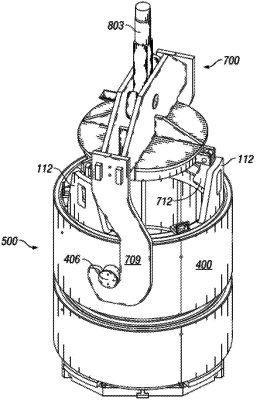| CPC G21F 5/008 (2013.01) [G21C 19/32 (2013.01); G21F 5/06 (2013.01); G21F 5/14 (2013.01)] | 18 Claims |

|
1. A transfer cask system for transferring spent nuclear fuel from wet storage to dry storage, the transfer cask system comprising:
a lifting device comprising a first support assembly and a second support assembly, the first support assembly comprising a plurality of parallel plates extending outwardly along a longitudinal axis of the lifting device and a plurality of first lifting hooks coupled to ends of the plurality of parallel plates and extending downwardly from the first support assembly, the second support assembly being affixed perpendicular to the first support assembly, and the second support assembly comprising a second plate and a plurality of second lifting hooks uniformly disposed around a peripheral of the second plate;
a cylindrical container comprising a side wall, a top, and a bottom that define a cavity configured to support a canister comprising spent nuclear fuel, the plurality of second lifting hooks being engaged with a plurality of lifting members extending upwardly from the top of the cylindrical container; and
a cylindrical sleeve disposed around an exterior of the cylindrical container, the cylindrical sleeve comprising a plurality of trunnion pins extending outwardly from an exterior of the cylindrical sleeve and being engaged with the plurality of first lifting hooks.
|